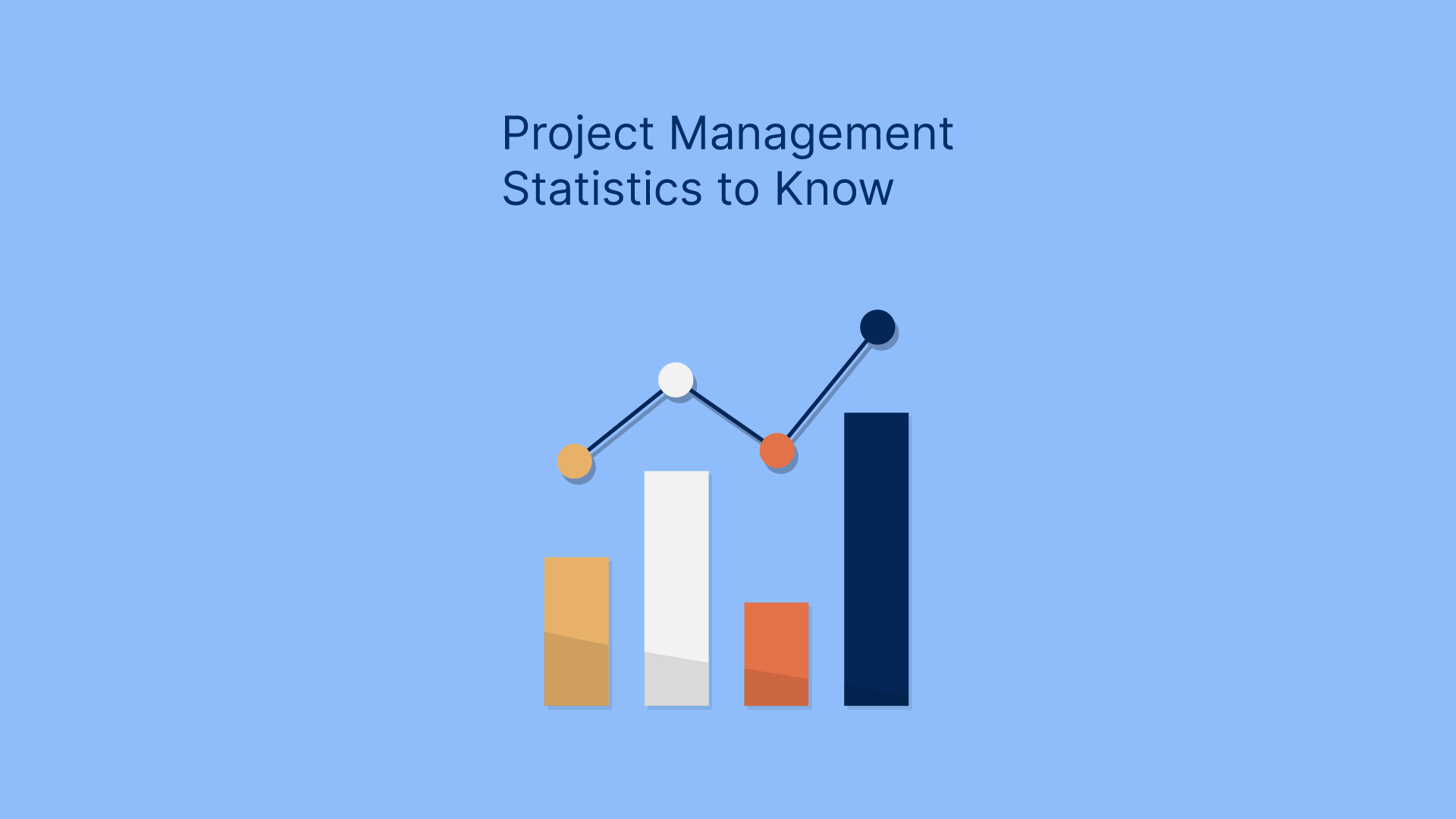Project management software has come a long way in recent years. And today, project management professionals have access to great project management software. This software, often referred to as a project management tool, makes their work easier and more efficient.
There are many different types of project management software out there. This includes personal productivity tools and cloud-based project management tools. From these, we have found statistics related to the project management industry to be worth knowing.
Statistics in project management have undergone changes over the last several years. Most notably in the areas of resource management, budgeting, resourcing, and even technology.
Getting to know these important project management statistics and why they are relevant is a big step toward understanding how you can better your projects.

The State of Project Management
The state of project management is constantly evolving, with new trends and technologies emerging every year, posing both opportunities and challenges for the project manager. According to a recent survey, a staggering 70% of project managers believe that project management software is essential for their success.
This sentiment is reflected in the projected growth of the global project management software market, which is expected to reach $15.08 billion by 2030, growing at a Compound Annual Growth Rate (CAGR) of 10.68%.
This growth is driven by the increasing demand for project management professionals and the need for organizations to improve their project management practices.
As businesses strive to enhance efficiency and effectiveness, the role of project management software becomes increasingly critical.
Project Management Industry Growth and Demand
The project management industry is experiencing a remarkable surge in growth and demand for skilled professionals.
As reported by the Project Management Institute, the global economy will demand 87.7 million project management roles by 2027. This surge translates to a plethora of job opportunities for project management professionals.
According to the Project Management Institute (PMI), the global project management market is projected to reach an impressive $15.08 billion by 2030, growing at a robust Compound Annual Growth Rate (CAGR) of 10.68%.
This growth is fueled by the increasing necessity for organizations to deliver projects efficiently and effectively, underscoring the critical role of project management professionals.
Moreover, the demand for project management professionals is set to continue its upward trajectory. The PMI forecasts that by 2027, the industry will need to fill over 88 million project management roles.
This presents a golden opportunity for individuals aspiring to build a career in project management and for organizations aiming to bolster their project management capabilities.
As the project management industry expands, the need for adept project management professionals becomes ever more crucial.
Project Management Methodologies
Agile Adoption: Agile methodologies have seen significant growth, with 71% of U.S. companies implementing Agile as their primary project management method. Within Agile frameworks, Scrum is particularly prevalent, accounting for 66% of Agile implementations.
Hybrid Approaches: Approximately 60% of project managers are now utilizing a hybrid project delivery approach, blending elements of both Waterfall and Agile methodologies to better suit project needs.
Project Management Software Usage
Market Leaders: Jira leads the project management software market with a 20.59% market share, followed by Microsoft Project at 16.01%.
Adoption Rates: Despite the availability of advanced tools, only 25% of companies use project management software in any capacity, with the remaining 75% relying on tools like Excel or paper-based methods.
Project Success and Failure Rates
Failure Statistics: Approximately 70% of projects fail to deliver the desired results to customers.
Success Factors: Projects with clear goals and stakeholder engagement are significantly more likely to succeed. Specifically, 74% of projects with well-defined objectives achieve success.
Project Management Professional Landscape
Demand Growth: Employers will require 87.7 million project management professionals by 2027 to meet the growing demand in project-oriented sectors.
Salary Insights: In the United States, the median annual salary for project management specialists is $94,500, with the top 10% earning more than $159,140 per year.
These statistics underscore the evolving landscape of project management, highlighting the increasing adoption of Agile and hybrid methodologies, the critical role of effective project management software, and the growing demand for skilled project professionals.
Project Management Software Statistics in the Industry
While project management software applications in the past had steep learning curves and took a good deal of hard work to understand, recent strides have largely addressed this.
This makes the software much more user-friendly. They have managed to keep their own unique features, making it a very useful tool for businesses.
Whether your business is small or large, a project management software dashboard can help you more effectively plan and carry out your tasks.
The following project management software statistics are reflections of recent trends in the project management space.
40% of the project and program governance activities of organizations are considered very effective (KPMG, 2020).
Only 58% of organizations understand the value of project management.
Standardized project management practices are reportedly being used by 93% of organizations.
Only 23% of organizations use a project management software like monday.com for managing projects.
The project management software market is expected to register a Compound Annual Growth Rate (CAGR) of 10.67% from 2020 to 2025. (Mordor Intelligence, 2020)
According to Project Management Institute, 73% of businesses believe that the three go-to requirements for choosing a project management software are reliability, ease of use, and ease of integration.
Project management Professional (PMP) certificate holders earn 22% higher salaries than those without. (PMI)
Around 1.2 million project management and business operations specialists are hired in the US. (US Bureau of Labor Statistics, 2021).
Benefits of Using Project Management Software
The adoption of project management software brings a multitude of benefits to organizations, significantly enhancing project success rates, efficiency, and team collaboration.
According to a report by Wellingtone, 71% of organizations utilize project management software, and 60% of project managers believe that these tools can substantially improve team collaboration and communication.
Project management software enables organizations to better manage their projects by providing tools for tracking progress, identifying risks, and allocating resources effectively.
This leads to improved project outcomes, including heightened customer satisfaction, reduced costs, and enhanced quality.
By leveraging project management software, organizations can streamline their processes and achieve greater project success.
Project Planning Statistics
It is common knowledge that most projects live and die at the design and planning stage. You’ve got tons of resources at hand, including dedicated project management software. The problem is, most are not being used to their full potential.
When it comes down to it, these mistakes will cost your business in the short and long term unless you gather your teams and work toward a standard methodology throughout the organization.
There is something for everyone in these project planning statistics. From what you need to know about your project management office (PMO) and the standard software you should consider to choosing the right project delivery method for your new website project, these statistics will surprise and amaze you!
About 55% of organizations do not have access to real-time project KPIs (Wellingtone, 2020).
Only, 60% of project managers report that they always apply a defined project methodology.
Also, 50% of organizations mostly or always baseline their project schedules (Wellingtone, 2020).
According to KPMG, 67% of organizations include project change management in their initiatives.
Nearly, 72% of PMOs are projected to increase in scope and responsibilities, up from 61% in 2019 (Wellingtone, 2020).
About 53% of organizations that are considered project management technology innovators apply agile techniques (PMI, 2019)
Project Performance Statistics
One fact that has remained constant is that delivering a project on time and on a budget is always a high priority for the project team and project success.
However, this doesn’t stop many business owners from constantly screaming out for cost reduction or better management when they find themselves in the thick of it.
What most people don’t know is that there are a lot of factors that give projects their chance for success. Here are some key factors that contribute to the best-performing projects.
77% of high-performing projects use project management software (Hive, 2020).
40% of projects mostly or always deliver their full benefits (Wellingtone, 2020).
60% of project management always or mostly engages in risk management (Wellingtone, 2020).
29% of projects are mostly or always completed on time (Wellingtone, 2020).
To improve performance, 68% of organizations emphasize developing leadership. Also 65% focus on developing the technical skills of their personnel (PMI, 2020).
About 36% of spend one or more days annually collating project reports (Wellingtone, 2020).
89% of organizations have one or more PMOs; 26% of these are less than two years old (Wellingtone, 2020).
Interestingly, 54% of organizations do not have access to real-time KPIs (Wellingtone, 2020).
The Scaled Agile Framework is the most popular scaling method with 35% of organizations applying it. (Digital.ai, 2020)
Project Failure Statistics
No matter how good the idea and how talented the team is, project failures will occur if project managers and executives don’t address their biggest problem: project management.
Project failure rates have remained fairly steady over the past few years. About one-third of projects are cancelled or terminated before completion.
The biggest factors contributing to this trend include an incomplete definition of goals, lack of executive support, and inadequate funding.
Almost one in five project managers have thought of leaving their jobs (Girl’s Guide to Project Management, 2021).
47% of agile projects are late, have budget overruns, or result in unhappy customers (Scrum inc, 2021).
According to Scrum, in 2021 11% of agile projects fail outright and end up delivering nothing
25% of organizations sometimes or never create scoping documents for projects (Wellingtone, 2020).
Organizations with low-value delivery maturity have a project failure rate of 21%, much higher than those of organizations with high-value delivery maturity, which have a failure rate of 11% (PMI, 2020)
Project Management Methodologies and Trends
Project management methodologies and trends are constantly changing, and it’s essential for project management professionals to stay up-to-date with the latest developments.
Effective project portfolio management is crucial for preparing project managers and PMO offices for automation and technology adoption.
Agile methodologies have revolutionized project management, with 60% of project managers believing that agile project management can significantly improve project delivery and quality. This approach emphasizes flexibility, collaboration, and customer satisfaction, making it a popular choice among project teams.
Additionally, hybrid project delivery is gaining traction, with 71% of organizations now using a combination of agile and traditional project management approaches. This blend allows teams to leverage the strengths of both methodologies, ensuring a more adaptable and effective project management process.
Hybrid Project Delivery and Agile Methodologies
Hybrid project delivery and agile methodologies are gaining significant traction in the project management industry. According to the PMI, 60% of project managers now employ a hybrid project delivery approach, which combines elements of traditional and agile methodologies.
Agile methodologies prioritize flexibility and adaptability, allowing teams to respond swiftly to changes and deliver value to customers.
Hybrid project delivery approaches offer the best of both worlds, balancing the need for structure with the flexibility to adapt to evolving project requirements. This blend ensures that projects meet the diverse needs of all stakeholders, making it a preferred choice for many organizations.
Project Management Offices (PMOs) and Remote Work
Project management offices (PMOs) are becoming increasingly integral to organizations, often tasked with overseeing multiple projects and ensuring they are delivered on time, within budget, and to the required quality standards.
The rise of remote work has further highlighted the importance of PMOs in maintaining project oversight and coordination.
According to the PMI, 71% of organizations now allow remote work, although only 45% of project managers work remotely full-time. PMOs play a crucial role in supporting these remote work arrangements by providing a structured framework for managing projects and ensuring successful delivery.
They offer training and support for project managers, develop project management processes, and align projects with organizational goals.
PMOs and Remote Work Arrangements
PMOs are pivotal in facilitating remote work arrangements, offering a robust framework for managing projects and ensuring their successful delivery.
They provide essential training and support for project managers, develop comprehensive project management processes and procedures, and ensure that projects align with organizational objectives.
In addition, PMOs enhance communication and collaboration among team members, serving as a centralized point of contact for stakeholders. This support is vital for ensuring that projects are delivered successfully, even in a remote work environment.
By leveraging the capabilities of PMOs, organizations can navigate the complexities of remote work and achieve their project goals effectively.
These new sections provide a comprehensive overview of the current trends and future directions in the project management industry, emphasizing the importance of project management software, methodologies, and the role of PMOs in supporting remote work.
Project Management Skills and Training
Project management skills and training are essential for project management professionals to succeed in their roles.
According to a survey, 61% of companies provide some form of project management training, recognizing the importance of continuous learning and development.
Furthermore, 47% of companies have defined specific career paths for project managers, highlighting the structured approach to career progression in this field.
The most in-demand skills for project managers in 2023 include Agile, Scrum, and Kanban, reflecting the growing emphasis on agile methodologies.
Additionally, project management certifications such as PMP, PRINCE2, and Agile are highly valued, as they demonstrate expertise and commitment to the field, making professionals more competitive in the job market.
The Future of Project Management
The future of project management will be shaped by emerging trends, technological advancements, and industry professionals.
Artificial intelligence (AI) and machine learning (ML) are set to play a significant role in project management, with AI-powered project management tools providing real-time data and insights to enhance decision-making. Tools like ChatGPT can also assist with various project management activities, from planning to execution.
As the project management industry continues to evolve and grow, the demand for project management professionals is expected to rise. To succeed in this dynamic environment, project management professionals will need to stay up-to-date with the latest trends and best practices, ensuring they are equipped with the skills and knowledge to manage projects effectively.
Use These Stats to Better Manage your Projects
The future of project management is one that’s changing so rapidly that your investments in this software need to keep pace with the latest project management statistics.
To succeed, be sure to select project management software that is going to be the most flexible and powerful option for your needs.
Project managers, who can have such a powerful effect on so many different aspects of both individual and company success, face unique challenges that require specialized tools and skills. These numbers provide valuable insight into what these professionals will be facing in the future.
Armed with this information, project managers can ensure they are up-to-date on all of today’s most relevant trends and skillsets so that they can more successfully manage all of the projects they oversee.
Frequently Asked Questions (FAQ) about Project Management
What are the statistics of project managers?
Project managers play a crucial role in the success of projects across various industries. According to the Project Management Institute (PMI), there will be a need for 87.7 million project management professionals by 2027.
The demand is driven by the increasing number of projects and the need for skilled professionals to manage them effectively.
How are statistics used in project management?
Statistics in project management are used to analyze project performance, track progress, and identify areas for improvement. They help project managers make informed decisions, optimize resources, and achieve project objectives. Key metrics often include project success rates, budget adherence, and time management.
What is 90% of a project manager’s job?
A project manager’s job is primarily focused on communication. It is estimated that about 90% of a project manager’s time is spent communicating with team members, stakeholders, and clients to ensure that everyone is aligned with the project’s goals and objectives.
What are the statistics of PMP?
Project Management Professional (PMP) certification holders are highly sought after in the industry. On average, PMP-certified professionals earn 22% higher salaries than their non-certified counterparts. The certification is recognized globally and demonstrates a high level of expertise and commitment to the field.
What is the success rate of project management?
The success rate of project management varies depending on several factors, including project complexity, stakeholder engagement, and the use of effective project management practices. Studies show that projects with well-defined goals and active stakeholder involvement have a success rate of 74%.
These FAQs provide a quick overview of some common questions related to project management, offering insights into the roles, statistics, and trends shaping the industry.







